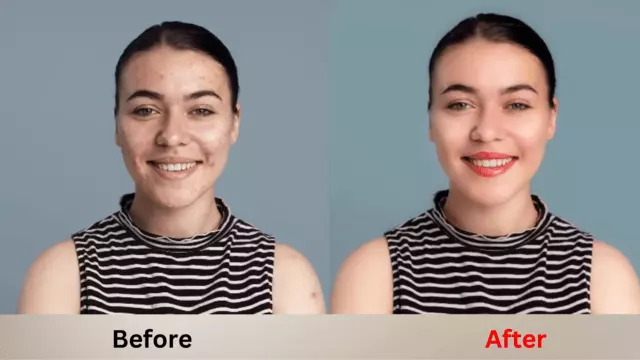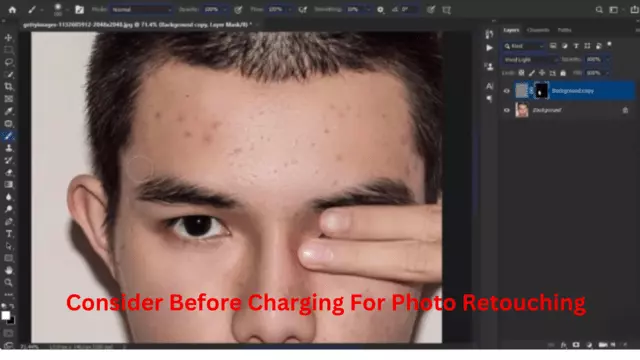As a retoucher, how much should you charge for each photo? If you are already providing this service, you have the immediate answer. However, setting an appropriate charge is undoubtedly challenging for newbies or someone starting a photo retouching business.
The payment for photo retouching cannot be said in a single line. Every retoucher has a different skill level, cost, and client type. Besides, the charge varies a lot depending on the retouching complexity and the client’s requirement. The average hourly rate for the service is $20 to $100. Except for the hourly billing system, there are more billing models widely used with different rates.
In this blog post, we will discuss those different billing models for photo retouching and the standard rates to charge for photo retouching services.
Different Billing Styles For Photo Retouching Service

For photo retouching services, you can charge in various formats, including package, hourly rate, or project-based. Here is the discussion of each model so you can easily find your ideal one.
Package model
With fixed options and transparent pricing, the package-based model lets clients choose their desired service in budgets. This type of offering includes specific services. For example, editing a certain number of photos in a specific price range. Thus, clients get standard retouching services at an affordable price range.
Each retouching service provides a unique package. So, its pricing varies a lot. On average, packages range between $50 and $200.
Here is a dummy photo retouching package to describe how it works:
| Package name | Price | Service included |
| Beginner | $50 | Maximum 10 images, basic color correction, and minor blemish removal. |
| Standard | $100 | Up to 20 images, color correction and enhancement, skin smoothing, and lightweight object removal. |
| Pro | $200 | Maximum 30 images, advanced color correction and enhancement, professional skin retouching, background replacement, and personalized filters. |
Though package billing is the easiest option to offer, it can be inflexible as well. Sometimes, it may not match a client’s unique needs. Also, this type of charging is inapplicable for retouching projects with complexity and variety.
Hourly rate model
This billing model depends on the actual time spent on retouching the client’s photos. It offers clients excellent flexibility and allows them to pay for the precise hours given to their project. Hour-based charging is highly suitable for projects with complexity and more variations. You can even customize the charging depending on the job’s complexity.
Generally, the hour-based billing ranges from $20 to $100.
Though the process offers flexibility, clients may find it challenging to predict the final cost. The reason is that charges often cross their budget. Also, it can be challenging for you to accurately track the working time and maintain transparency between you and the client.
Project-based model
Project-based billing is planned based on the client’s unique requirements. For example, you can customize a price for the entire project considering the number of photos and the work’s complexity. Here, the retoucher has to offer a personalized quote to the client, describing what tasks will be done within the mentioned deadline and budget.
This billing model is quite effective in the case of a one-time project. The average charge for each photo is from $3 to $25.
If the task is small and repetitive, this billing method can be inefficient. Also, detailed project planning and proper communication can be very challenging for both parties.
How Much To Charge Based On Retouching Complexity
Unlike the above formats, you can charge for photo retouching services depending on the work’s complexity. This discussion will provide you with ideas for such a billing style.
Basic Retouching
In basic photo retouching, images are improved without much modification. This service usually offers color adjustment, cropping, exposure fixing, red-eye fixing, noise reduction, and background removal. Here, retouchers ensure a better appearance of photos, not massive changes. Basic retouching is perfect for various types of photography. You can charge from $ 0.5 to $1 per photo for this service.
Moderate Retouching
Moderate retouching covers more detailed and in-depth work than basic editing. For example, photo editors offer wrinkle reduction, skin texture improvement, and teeth and eye enhancement in such retouching. Here, photos are more polished without ruining their natural look. Moderate retouching is often applied where high-quality images are required. As a retoucher, you can charge $2 to $3 for each image.
Advanced retouching
Advanced photo retouching is the best option where complex editing is required. This type of retouching covers object removal, background replacement, special effects, makeup enhancement, and customized image creation. Advanced retouching has a high demand in the fashion and advertising industry, as they need both creativity and high visual impact. For such retouching work, you can charge from $5 to $10 per photo.
Things To Consider Before Charging For Photo Retouching Service

Setting appropriate charges for photo retouching should not be guesswork. Instead, find out the value you can offer to clients and fix your service rate accordingly. Consider the below things before finalizing your service charge.
Your skill:
A retoucher’s expertise and experience matter the most when setting a rate for this service. If you are highly skilled in this work, clients will pay you willingly. So, you should note your core skills and knowledge in retouching before deciding the rate.
Time and effort needed:
Predict the time required for a project and set the charge according to the effort it needs. You must also consider whether the work is complex or require additional revisions. For easy retouching work, the charge can be affordable. In contrast, you should charge high if it is a troublesome project.
Market demand:
The rate for photo retouching can be low to high, depending on the market demand for the service. It also depends on the market competition. So, check the charge of other retouchers first. If you offer a particular type of photo retouching service that no one or a few are offering, you can charge higher for this specialty.
Operational cost:
You must also estimate the functional cost behind the service. It may include the money spent to manage your team, fees for software, office fare, and others. Note every cost utilized for the service and set your service charge so you do not lose the profit.
Profit margin:
Finally, evaluate how much profit you want to generate from the service. Do not expect a high-profit margin overnight. Instead, keep a balance between your cost and profit percentage. You can also analyze your competitor’s charge range to get the idea. If you can set an attractive rate considering your skill and value, it will definitely draw the client’s attention.
Frequently Asked Questions
1. Is editing and retouching photos the same thing?
They are not the similar thing. Photo editing covers a wide area that involves a lot of work. Retouching primarily focuses on photo quality enhancement.
2. Can you raise the service charge later?
Of course. You can gradually enhance the service charge by adding more value and features to your services.
3. Which type of photo retouching is commonly offered to clients?
In general, photo resizing, color correction, shape adjustment, and defect removal services are offered to clients.
Conclusion
Setting a service charge for photo retouching is not a guesswork. To find the appropriate billing amount and model, you must evaluate your expertise, market demand, project complexity, and operational costs. The final amount should not be too low or too high to undervalue your service or discourage clients. Whichever billing model you prefer, ensure transparency and value to make clients comfortable working with you.
